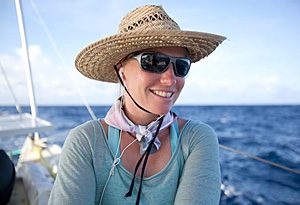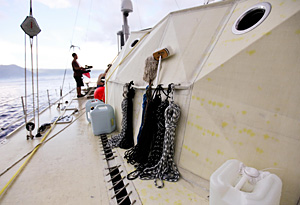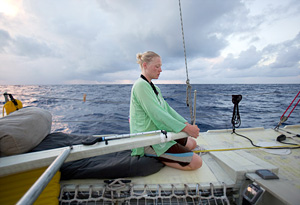We Are All Sea Creatures

Photo: Luca Babini
Whether you're reading this in an office at the top of a skyscraper in an urban metropolis or while looking out of your kitchen window over the corn fields of Iowa, you're still indebted to the ocean. Jo Royle, skipper of the Plastiki—a boat made of 12,500 recycled plastic bottles—pays homage to that "beautiful deep blue" and urges you to fight to save it.
The ocean covers more than 72 percent of the planet, drives the world's weather systems and creates more than half of the oxygen we breathe. As such, it forms an absolutely crucial part of our very existence and everyday life on earth. As the skipper of the Plastiki, my relationship with the ocean is very apparent. As I write this, I am in the middle of the Pacific, just a few degrees south of the Equator, under the shade of a reclaimed sail, listening to the Plastiki's inner workings and her 12,000 recycled plastic bottles moving through the waves. We are half-sailing, half-drifting our way from San Francisco, across one of the world's largest expanses of ocean, toward Australia.I have been a professional sailor most of my working life, taking lessons from the ocean on how to respect our planet and respond to an ever-changing environment. I have learned from experience that the moment you turn your back on Mother Nature, she will be sure to remind you of who is boss. As a sailor, it's easy to visualize how our survival is directly linked to the ocean. However, there was one very clear moment when it really dawned on me how little respect we, as humans, have for our life support system. It dawned on me that if I treated my boyfriend in the same way as we treated the ocean, he would no longer be around.
A few years ago, I realized a childhood dream, a voyage only a handful of sailors had successfully achieved: to circumnavigate South Georgia and visit the Antarctic. After a couple of weeks sailing along the northern shores, it was time to turn the corner. We began exploring the south side of the island, the windward facing shores of the notorious hostile Southern Ocean. Next stop: the Antarctic continent, a land that no nation claims and no human can permanently inhabit.

Photo: The Plastiki Crew
Wrapped up in so many layers that my waddle could have been mistaken for that of a penguin, I was taking a stroll to explore South Georgia's remote shoreline. I scrambled round the headland and down onto a small cove to be faced with a staggering accumulation of marine debris. This sight broke my heart, literally bringing a tear to my eye. How could we, as intelligent human beings, allow ourselves to have such a far-reaching impact on a land that doesn't even feel like it belongs to the human race? An area that only a handful, if anyone, has ever stepped foot on.
I immediately recalled sailing through dense areas of trash in the North Atlantic or into ports whose shores were covered with plastic. But I felt like such a privileged visitor here, welcomed by an abundance of species whose voices would never be heard. What on earth are we doing to the planet if how we consume has an effect here, miles from any populated town?
This encounter changed my life. I became driven to understand what affect we, as humans, are having on the planet—our life support system—and just how long the planet can sustain our creature habits. The ocean journeys I have embarked on since then have taught me how our actions right now shape the way future generations will live. These lessons have been empowering, making me think, act, feel. We can feel so trapped in routine, yet really we are free to choose the correct path.
Environmental issues once left me confused, with so many sides to every argument; problems so huge they can only be properly addressed by scientists, governments and futurists; and a feeling that an individual can't really make a difference.
But we can. Look at the example of the discovery of the five garbage patches in the oceans. These garbage patches are vortexes that form where two ocean currents meet—in effect, a giant oceanic toilet that never flushes. Capt. Charles Moore discovered the Great Pacific Garbage Patch, an area in the Pacific twice the size of Texas. The trash is literally transformed into a plastic soup, where one part plankton to six parts plastic could be trawled.
Upon further research, I discovered that 60 percent of the plastic found in these areas comprises of what can be called "one life plastic"—plastic bags, Styrofoam food containers and plastic drink bottles. These are items that are consumed in a flash to make life more comfortable but have a life expectancy that is seven times ours—500 years. This just doesn't add up. How can one hour in our possession equal 500 years on the planet? As consumers, the issue of marine debris is our problem, not that of the scientists, and we can help to stop it today.
I immediately recalled sailing through dense areas of trash in the North Atlantic or into ports whose shores were covered with plastic. But I felt like such a privileged visitor here, welcomed by an abundance of species whose voices would never be heard. What on earth are we doing to the planet if how we consume has an effect here, miles from any populated town?
This encounter changed my life. I became driven to understand what affect we, as humans, are having on the planet—our life support system—and just how long the planet can sustain our creature habits. The ocean journeys I have embarked on since then have taught me how our actions right now shape the way future generations will live. These lessons have been empowering, making me think, act, feel. We can feel so trapped in routine, yet really we are free to choose the correct path.
Environmental issues once left me confused, with so many sides to every argument; problems so huge they can only be properly addressed by scientists, governments and futurists; and a feeling that an individual can't really make a difference.
But we can. Look at the example of the discovery of the five garbage patches in the oceans. These garbage patches are vortexes that form where two ocean currents meet—in effect, a giant oceanic toilet that never flushes. Capt. Charles Moore discovered the Great Pacific Garbage Patch, an area in the Pacific twice the size of Texas. The trash is literally transformed into a plastic soup, where one part plankton to six parts plastic could be trawled.
Upon further research, I discovered that 60 percent of the plastic found in these areas comprises of what can be called "one life plastic"—plastic bags, Styrofoam food containers and plastic drink bottles. These are items that are consumed in a flash to make life more comfortable but have a life expectancy that is seven times ours—500 years. This just doesn't add up. How can one hour in our possession equal 500 years on the planet? As consumers, the issue of marine debris is our problem, not that of the scientists, and we can help to stop it today.

Photo: Luca Babini
As plastic breaks down in the ocean, it gets back into our food chain—not only in the fish we eat, but also in meat. Few people know it, but cattle feed is made from fish that have fed off the toxic particles of plastic found in the ocean. A study of swordfish found that one in three male swordfish lay female eggs due to plastic-derived toxins in the oceans. This imbalance may seem small, but it affects every part of the food chain, creating indeterminable damage to the natural world and human beings alike.
As a woman, I recently became acutely aware of plastics in cosmetics. Enjoying a good scrub in the shower one morning, I discovered that the exfoliating property in my shower gel was plastic. Crazy, I was scrubbing my skin with plastic particles. More importantly, these tiny plastic particles were being washed down the drain and eventually into the ocean, a topic so close to my heart. I was unconsciously adding to the problem of marine debris every morning when I took a shower.
In the English magazine Huck, Ruth Carruthers wrote: "On average, women in the western world use approximately 200 man-made chemicals in their skincare routine every day. Chemicals such as parabens, sodium laureth sulfate, and phthalates are found in most body care products." Scientific studies have linked these chemicals to skin disorders and hormone disruption. These toxins wash down our drains, end up in the ocean, are eaten by fish and work their way up the food chain onto our dinner plates.
So what is this toxicity in our food chain doing to our health and the health of our children? The scary thing about plastic is that even though we have the feeling that plastic is essential to modern life—it's used in practically every action that we make—we know so little about its potential for damage.
Wherever we live, we need to feel a connection to the oceans. With little effort, we can all start doing something to help. For the duration of the Plastiki expedition and beyond, I urge you to remember your reusable water bottle. This alone will help to reduce the 200 billion liters of bottled water consumed each year!
The Plastiki, a transoceanic sailboat made of 12,500 recycled plastic bottles, is on an expedition across the Pacific Ocean, lead by British explorer David de Rothschild. Learn more at ThePlastiki.org and make a Plastiki pledge at MyPlastiki.com.
Keep Reading:
It's not just BP—how a million tiny oil spills pollute our oceans every day
Plastiki expedition leader David de Rothschild takes on the plastic clogging our oceans
Learn more about the Plastiki's mission
As a woman, I recently became acutely aware of plastics in cosmetics. Enjoying a good scrub in the shower one morning, I discovered that the exfoliating property in my shower gel was plastic. Crazy, I was scrubbing my skin with plastic particles. More importantly, these tiny plastic particles were being washed down the drain and eventually into the ocean, a topic so close to my heart. I was unconsciously adding to the problem of marine debris every morning when I took a shower.
In the English magazine Huck, Ruth Carruthers wrote: "On average, women in the western world use approximately 200 man-made chemicals in their skincare routine every day. Chemicals such as parabens, sodium laureth sulfate, and phthalates are found in most body care products." Scientific studies have linked these chemicals to skin disorders and hormone disruption. These toxins wash down our drains, end up in the ocean, are eaten by fish and work their way up the food chain onto our dinner plates.
So what is this toxicity in our food chain doing to our health and the health of our children? The scary thing about plastic is that even though we have the feeling that plastic is essential to modern life—it's used in practically every action that we make—we know so little about its potential for damage.
Wherever we live, we need to feel a connection to the oceans. With little effort, we can all start doing something to help. For the duration of the Plastiki expedition and beyond, I urge you to remember your reusable water bottle. This alone will help to reduce the 200 billion liters of bottled water consumed each year!
The Plastiki, a transoceanic sailboat made of 12,500 recycled plastic bottles, is on an expedition across the Pacific Ocean, lead by British explorer David de Rothschild. Learn more at ThePlastiki.org and make a Plastiki pledge at MyPlastiki.com.
Keep Reading:
It's not just BP—how a million tiny oil spills pollute our oceans every day
Plastiki expedition leader David de Rothschild takes on the plastic clogging our oceans
Learn more about the Plastiki's mission



